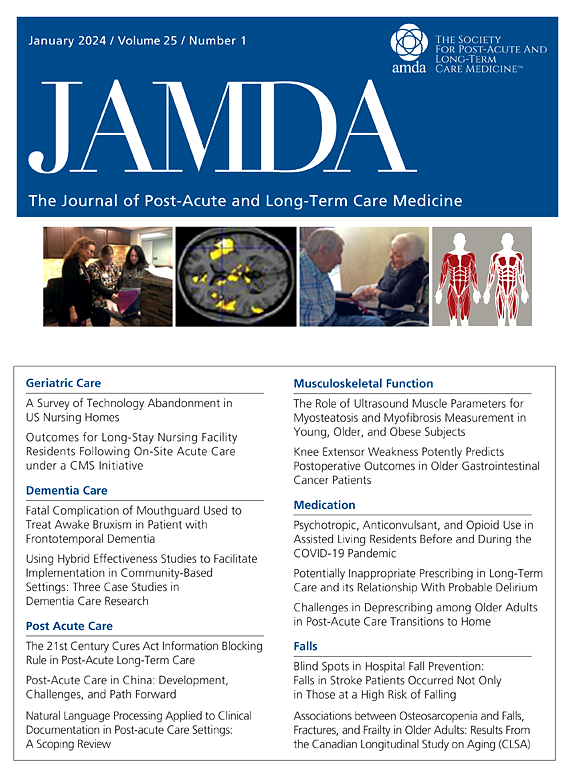用机器学习驱动的风险评估筛选/诊断肌肉减少症:SARCO X研究。
IF 4.2
2区 医学
Q2 GERIATRICS & GERONTOLOGY
Journal of the American Medical Directors Association
Pub Date : 2025-05-30
DOI:10.1016/j.jamda.2025.105683
引用次数: 0
摘要
目的:骨骼肌减少症给卫生保健系统带来了显著的发病率和经济负担,强调了早期/有效筛查和诊断的迫切需要。本研究旨在开发一种基于机器学习(ML)的算法来促进肌肉减少症的筛查/诊断。设计:横断面病例对照研究。环境和参与者:本多中心研究纳入年龄≥45岁的受试者。方法:获得年龄、体重、身高、教育/运动状况、吸烟、合并症等人口统计学资料。骨骼肌减少症的诊断使用基本和基于ml的算法,包括低股四头肌肌肉质量/厚度,结合椅子站立测试(CST)持续时间延长和/或手部握力降低(HGS)。结果:5649名参与者(1379名男性,占24.4%)中,1097名(19.4%)患有肌肉减少症。使用基于ml的模型,与肌肉减少症显著相关的因素是年龄、体重、身高、教育水平、运动状况以及是否存在高血压和糖尿病。在各种ML模型中,梯度增强分类器在holdout测试数据中显示出预测肌肉减少症的最高性能。对于ml增强算法,召回值为0.979;精密度值为0.926,诊断肌少症的准确度值为0.980。与简单的肌少症算法相比,ml增强算法进一步将HGS和超声的需求分别降低了38.1%和49.5%,表明其在优化肌少症诊断的同时最大限度地减少了医疗设备所需的检测。结论和意义:基于ml的算法显著减少了对肌少症诊断的检测/成像需求。它有助于识别肌肉减少症,特别是在初级和二级保健机构中,并减少应转诊进行进一步评估的个人数量。本文章由计算机程序翻译,如有差异,请以英文原文为准。
Screening/Diagnosing Sarcopenia with Machine Learning–Powered Risk Assessment: The SARCO X Study
Objectives
Sarcopenia imposes significant morbidity and economic burden on health care systems, underscoring the critical need for early/effective screening and diagnosis. This study aimed to develop a machine learning (ML)-based algorithm to facilitate the screening/diagnosis of sarcopenia.
Design
A cross-sectional case-control study.
Setting and Participants
This multicenter study enrolled subjects aged ≥45 years.
Methods
Demographic data such as age, weight, height, education/exercise status, smoking, and comorbid diseases were obtained. Sarcopenia was diagnosed using the basic and ML-based algorithms, which incorporate low quadriceps muscle mass/thickness, combined with prolonged chair stand test (CST) duration and/or reduced hand grip strength (HGS).
Results
Of 5649 participants (1379 males, 24.4%), 1097 of them (19.4%) were sarcopenic. Using the ML-based model, significantly associated factors with sarcopenia were age, weight, height, education level, exercise status, and presence of hypertension and diabetes mellitus. Of the various ML models, the Gradient Boosting Classifier (GBC) demonstrated the highest performance in predicting sarcopenia in the holdout test data. For the ML-augmented algorithm, the recall value was 0.979; the precision value was 0.926, and the accuracy value was 0.980 for making the diagnosis of sarcopenia. When compared with the basic sarcopenia algorithm, the ML-augmented algorithm further decreased the need for HGS and ultrasound by 38.1% and 49.5%, respectively, demonstrating its effectiveness in optimizing sarcopenia diagnosis while minimizing testing required for medical device(s).
Conclusions and Implications
The ML-based algorithm significantly reduces the need for testing/imaging in the diagnosis of sarcopenia. It facilitates the identification of sarcopenia particularly in the primary and secondary care settings and decreases the number of individuals who should be referred for further evaluation.
求助全文
通过发布文献求助,成功后即可免费获取论文全文。
去求助
来源期刊
CiteScore
11.10
自引率
6.60%
发文量
472
审稿时长
44 days
期刊介绍:
JAMDA, the official journal of AMDA - The Society for Post-Acute and Long-Term Care Medicine, is a leading peer-reviewed publication that offers practical information and research geared towards healthcare professionals in the post-acute and long-term care fields. It is also a valuable resource for policy-makers, organizational leaders, educators, and advocates.
The journal provides essential information for various healthcare professionals such as medical directors, attending physicians, nurses, consultant pharmacists, geriatric psychiatrists, nurse practitioners, physician assistants, physical and occupational therapists, social workers, and others involved in providing, overseeing, and promoting quality

 求助内容:
求助内容: 应助结果提醒方式:
应助结果提醒方式:


